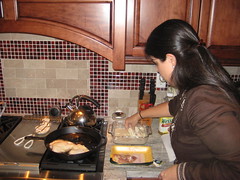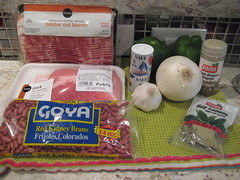Saturday, December 26, 2009
54: Pastel de Medianoche
2 1/2 cups flour
1/2 cup sugar
1 teaspoon double acting baking powder
1/4 teaspoon grated nutmeg
1/2 teaspoon salt
1/4 pound (1 stick) butter
2 egg yolks
1 whole egg
1/4 cup dry white wine
1/4 cup oil
For the filling:
1/2 pound sliced sweet ham
1/2 pound sliced swiss cheese
1/2 pound sliced roasted pork
1/4 pound sliced turkey breast
1/2 pickle, chopped
1 teaspoon mustard
For the egg wash:
1 egg yolk
1 teaspoon milk
1. Preheat oven to 375 degrees.
2. Sift the flour with the sugar, baking powder, salt and nutmeg.
3. Add the butter and cut with a pastry cutter until little pellets form, or until you have a sand-like consistency.
4. Beat the egg yolks, whole egg, oil and cooking wine together.
5. Add to the dry ingredients and mix together with a fork until well blended.
6. Pat out the dough and divide into two parts.
7. Put one of the parts on the bottom of a greased, 9" glass pie plate.
8. Spread half the mustard on the dough.
9. Place the ham, pork, turkey, cheese and pickles in layers.
10. Spread with the remaining mustard.
11. Repeat the ham, pork, turkey and cheese layers.
12. Top with the second part of the dough.
13. Brush the egg wash over the top of the dough.
14 Seal the edges with a fork and cut holes in the middle of the top dough to let the steam cook out.
15. Cook until golden, approximately 50 minutes.
Makes 8 servings.
Pastel de Medianoche
Yes, as in a midnight Cuban sandwich.
Yes, as in a midnight Cuban sandwich pie.
---End of blog post---
When I first read through all the recipes in the book, I read this and took a double take. You first build your own dough for the top and bottom crusts, from scratch, and then build a medianoche sangüiche (midnight sandwich) in between.
It’s scary. It really is. And as you’re going through the process the first time, I’ll advise for someone to hold your hand, or help you balance on one leg because that dough is soft, mushy and very hard to handle.
But when it’s baked to crispy golden perfection and the smell of the hot swiss cheese, ham, turkey and Cuban pork come wafting out of your oven – you know you just have to sit down and realize what you’ve just accomplished.
You’ve achieved absolute homemade Cuban greatness.
Recipe #416: Pastel de Medianoche
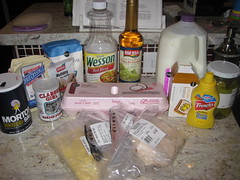 This recipe starts with a visit to your grocery deli and an incredibly sweet attitude. You’ll need the sweetness because when you ask the deli person what you need for them to do for you, they may not be so customer service friendly.
This recipe starts with a visit to your grocery deli and an incredibly sweet attitude. You’ll need the sweetness because when you ask the deli person what you need for them to do for you, they may not be so customer service friendly.Luckily, the Publix at Dadeland has a deli person named Julie that is beyond sweet. I’ve done this to her twice already and even after she helped me the first time, she still says hi and helped me out a second time when I made this recipe for my cousin’s baby shower a few weeks after making the pastel the first time.
If you don’t go to the Dadeland Publix and have Julie to help you, then simply write what you need on a piece of paper and just give it to the deli person with a smile. Maybe you don’t need to do it this way, but since I’m a super nerd when it comes to my food prep, this is how I ask for the ingredients:
Hi! I’ll need four different types of bags for my ingredients. They’re all ½ pounders, except for one that’s a ¼ pound. They’re all sliced thin, but not see-through, rippable thin. The slices need to not rip.
The ½ pounders are: sweet ham, swiss cheese and Cuban roast pork.
The ¼ pounder is smoked turkey.
See, simple. Julie helped me find the best way to ask for my order. At first, I was scared to ask her because I actually wanted to make two of these pasteles for a Christmas dinner so I had six ½ pounders and two ¼ pounders…but see, then I start getting complicated.
Leave the order as above and just make one pastel. At least make just one the first time. Then, you can show off and make this your signature dish at baby shower buffets!
Once you get the deli bags home, put everything in the fridge and get the ingredients for the dough out.
You start by sifting flour, sugar, salt and grated nutmeg with Polvo Royal. Polvo Royal is double action baking powder, not gelatin powder like I first thought. That would have made this a real disaster. Thanks to a little asking around and some help from a cashier’s at Sedanos, I found out what Polvo Royal was. And, it seems that in Cuba they didn’t have double action, but only single action, so since this recipe calls for two teaspoons of Polvo Royal, you cut it by half to one teaspoon.
Once you’ve sifted all the dry ingredients, you add a stick of butter, a tablespoon at a time, and mix it well with a pastry mixer. I actually bought mine randomly a few weeks ago at Publix and couldn’t believe it was coming in so handy for this recipe. i had never even seen one in person before - only on Food Network.
 Once you have the butter mixed in, you should see a grainy texture, kind of like sand, or like little tiny pellets. Then, you add in the wet ingredients – egg yolks that you have beaten into a whole egg BEFORE you put them into the mix (oops), dry white cooking wine and vegetable oil. Make sure it’s all mixed in well, using a spatula or wooden spoon. Then, knead the dough with your hands, just a little.
Once you have the butter mixed in, you should see a grainy texture, kind of like sand, or like little tiny pellets. Then, you add in the wet ingredients – egg yolks that you have beaten into a whole egg BEFORE you put them into the mix (oops), dry white cooking wine and vegetable oil. Make sure it’s all mixed in well, using a spatula or wooden spoon. Then, knead the dough with your hands, just a little.Here’s the weird part – the measurements Nitza gives makes this dough too wet to handle easily. It doesn’t drip, but it sticks so much to your hands, you’ve got to work quickly. I learned the second time, that if you divide the dough in half and wrap each half immediately with plastic wrap and throw it in the fridge until you can breathe again, it helps.
I won’t say the measurements are wrong, however, because the end result is just perfect; I’m just saying this masa (dough) is a bear to handle.
While the masa is chilling so it behaves when YOU’RE ready, take out a round 9" glass pie Pyrex. Grease it up with butter, of course. Ack, my arteries.
Get one of the wrapped halves of masa and take it out. Pat it while still inside the plastic wrap. Why? Because Ms. Chef here didn’t own a rolling pin. And when did I realize it? Right at this moment in the recipe.
Why can’t I remember to really read through the whole recipe? Nitza doesn’t even mention a rolling pin. I read over "rodillo" and didn’t even think twice that she was talking about a rolling pin.
But, guess what? The dough is so sticky, the rolling pin I now own – my beautiful Kris Kringle gift from Williams Sonoma that matches the red in my kitchen (thanks, Sandra!) – doesn’t work with this. The dough sticks tooooooo much!
So, you pat it out, into the bottom of the greased Pyrex, with your hands. In the baking, I promise you that all the imperfections get erased. Just make sure you have the bottom fully covered and up the sides fully covered as well. That’s the bottom crust for your pie. It will be fine without being perfect.
 Think of this as a rustic dish!
Think of this as a rustic dish!Then, the fun part begins…the layering of the medianoche sangüiche guts. You squeeze out some zig zags of mustard all along the bottom and spread gently (gently!) with a butter knife (or non sharp knife). Now, let your inner obsessive compulsions run free as you lay down the first layer of ham, round and round right on top of the mustard. Then, layer the turkey, then the pork, then the swiss cheese.
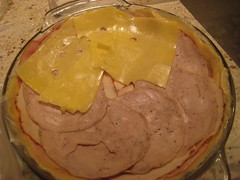 And then some more mustard and…the pickles. Slices of kosher dill pickle, just like the ones in the sangüiche you know and love. You can make this half pickles and half non-pickles if you've got picky eaters.
And then some more mustard and…the pickles. Slices of kosher dill pickle, just like the ones in the sangüiche you know and love. You can make this half pickles and half non-pickles if you've got picky eaters.  Another round of layering and you end with the ooey gooey swiss cheese, right before closing the pie with the top masa lid. You know that top cheese is just going to seep way, way down and melt all the flavors together.
Another round of layering and you end with the ooey gooey swiss cheese, right before closing the pie with the top masa lid. You know that top cheese is just going to seep way, way down and melt all the flavors together.Now, take the second masa out of the fridge. If you have one of those bendable, thin plastic cutting boards, use it here so that you can pat out the masa with your palms to the size you need to cover the pie. If not, use parchment paper and gently lay the dough over the pie while still on the parchment paper.
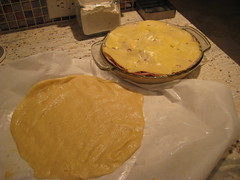
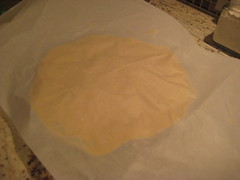 Remember that this dough is very forgiving (it better be for the pain it is to work with) and you can actually fix the top if it didn’t land exactly how you wanted it to land.
Remember that this dough is very forgiving (it better be for the pain it is to work with) and you can actually fix the top if it didn’t land exactly how you wanted it to land.Then, with a fork, you crimp the edges and with a sharp knife, you make slits on the top, like a real fancy baker would do.
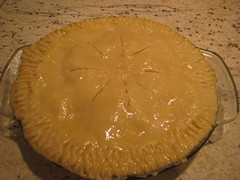 And that’s it. You put it in the oven that had been preheated to 375 degrees and let it bake for 50 minutes.
And that’s it. You put it in the oven that had been preheated to 375 degrees and let it bake for 50 minutes. Other tips that I’ll share, now that I’ve made three of these pasteles –
Other tips that I’ll share, now that I’ve made three of these pasteles – Don’t offer to bring this as an appetizer, unless you trick yourself and say that your party starts two hours before it really starts. Either that, or just have this served with the main dish. Each time I’ve taken it somewhere, we end up being late because it takes so long to make.
Watch out with dripping juices. I think it’s the ooey gooey cheese that bubbles over, but make sure you use good oven mitts or kitchen towels to take the pastel out of the oven.
Bring a second one. You’ll find yourself serving 16 pieces to feed the army you call your family and then the 17th person, most likely your abuela, will come and she’ll be left empty handed. You don’t want to do that. Bring a second pastel (after you’ve made just one simple one in the kitchen one day with lots of time and no pressure – ha!).

This can be your signature dish. It’s become mine so far. I’ll take this dish anywhere, anytime. Man, I wish the ingredients for Herald Top Chef would have been pickles and sticky dough – I would have taken Top Chef Silvia down for the count!
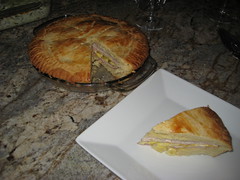
Friday, December 25, 2009
Tia Alicia is Cuban then Mexican
Although Alicia’s entire grown up life was made in Mexico, she still considers herself as Cuban as the rest of her family here in Miami. Her whole side of the family – daughter, son in law, grandkids, and even her husband consider themselves part Cuban.
Tia Alicia even hangs out with Las Cubanas, a group of Cuban women that were born in Cuba, like her, and live in Mexico. They drink their cafecito Cubano and play Canasta (the card game) every time they get together.
Tia and Tio make it a habit of visiting Miami often. On a good year, they’re here to celebrate the holidays with us. To my good fortune, they were here in 1997, the first Christmas I spent with my husband’s family, while we were still dating.
On Christmas morning, many of us wake up early and dash to the tree to see what St. Nick has left for us. In my husband’s family, everyone wakes up in their respective houses, opens their gifts with their parents, and then continues the dash to my mother in law’s house.
We just recently started gathering at my mother in law’s. Remember, we all took on holidays after Moki’s passing. When Moki was around, we all used to meet up at noon-ish (Cuban time translation = between 2 and 3pm) to open all the cousin gifts.
We place all the gifts randomly around the living room, now set beautifully alongside my mother in law’s Christmas Village that takes a month to build (and take down). As soon as everyone has arrived and set their gifts in place, the almost twenty of us attack and spend a good half hour screaming each other’s names as we read the tags on each gift and hand them to the distracted recipient.
The trick is to grab a gift when you hear your name and start a pile in the corner. Before you know it, you turn around and you’ve got more than ten gifts waiting for you – it’s Christmas morning all over again!
And then, someone leaves their pile to make refried beans. At least when Tia Alicia is in Miami, she’s the one that is in the kitchen before anyone can realize it, cutting up onions and putting shredded cheese on plates as she heats up olive oil in a frying pan.
Out from the fridge comes a huge container of black beans. My mother in law’s black beans. Not the leftovers from Nochebuena. No, there’s usually no leftovers from Christmas Eve. It’s actually a fresh batch she had set aside that she made at the same time as the Nochebuena ones.
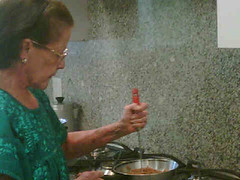
And into the hot oil they go. Scoop by scoop, in they go, and the mashing begins. Tia Alicia’s got this down to a science. She mashes and mashes and mixes and stirs and those black beans turn to puree and start coming together quicker than I’ve ever seen – and definitely quicker than it took me this first time doing the frijoles refritos without her.
Tia and Tio stayed in Mexico to spend Christmas with their daughter and grandkids. It was the perfect time for me to step in and take another recipe down from The Project.
Or so I thought. When a certain few in my family saw me headed for the kitchen, I got the looks, and comments:
- Are you going to the kitchen? You’re not going to do something from The Project, are you? Are you going to…do Tia Alicia’s frijoles?
- Yes.
- But…why do you have that Nitza book with you? You’re not going to make some crap frijoles recipe from that book are you?
- No. I’m going to make frijoles refritos.
- Tia Alicia’s frijoles?
- Yes.
- But why do you have that book? Does it have pimentos and olives and stuff?
- No.
- But we like Tia Alicia’s frijoles.
- Yes. They’re the same as Tia Alicia’s frijoles.
- But…Tia’s frijoles are Mexican. That’s how they make it in Mexico.
- No. Tia’s frijoles are Cuban and her recipe is from this book. Look, it’s made the same way.
Dead silence.
For a long time.
News flash, family – Tia Alicia is Cuban. Why would it be such a shock to them that my Nitza book has Alicia’s recipe in it?
This was an endless case of round and round but at the end of it all, I still think they thought I was nuts and that Tia Alicia’s recipe was exclusive to her.
Well, Nitza or Alicia, call it what you want, it’s the best thing to do with leftover black beans (if there are any).
Recipe #40: Frijoles Negros Refritos
Nitza says that the first thing you do is put the black beans in a colander/strainer to make them into a puree. I take the beans only (hardly any liquid – only if necessary) and mash them in a tablespoon of hot olive oil with a potato masher instead. You mash and stir the beans constantly until you see them coming together and binding like a thick paste.
They actually come towards the middle of the pan as you stir, and stay away from the edges since the liquid has evaporated and what you’re left with is a hummus-type of consistency.
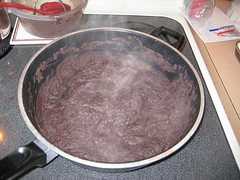
You scoop the refried beans on a plate, with chopped white onions, shredded cheese and/or chopped hard boiled eggs on top. I personally like all three on top, but hey, it’s up to you.
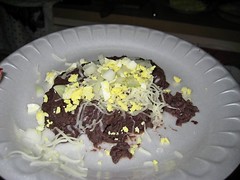
Easy easy. And, with a little practice, you’ll make your first batch in less than half an hour. You really have to learn how to play with the temperature of the heat you cook the beans over. The higher the heat, the better, but the greater the risk of burning the beans.
So, you play around with it, until you have it down to a science like Tia Alicia. And, before you know it, everyone will forget where the recipe comes from and they’ll think it’s unique to you. Or to Tia Alicia.
Whatever it is, I still don’t think my family believes I really made a recipe from The Project. I believe they think I gave in and made it like Tia Alicia makes it. Which I did, except that Tia Alicia learned how to make it from Nitza and just like all good Cuban dishes, that gets erased and it becomes unique to the cook.
So feel free to call this your own. Your family won’t know any better. Which is really what we all want – dishes to call our own.
And another recipe down. Lots more to go.
Saturday, December 19, 2009
Secret Ingredients: Sour Cream & Citrus
Our Executive Editor, Anders Gyllenhaal picked the secret ingredients and they were – sour cream and citrus.
Being the newbie, I assumed you had to use both ingredients (which I still think should be a requirement), and I went home to read every recipe in Cocina al Minuto until I found one that contained both citrus and sour cream.
I read the book for over an hour and could only come up with one.
And, it didn’t even have citrus – it is made with strawberries and pear but for this one time, it was time to alter the recipe and switch out the pear for mandarin orange. And key limes. Key lime makes everything taste better.
To be honest, I had no idea that a Pastel de Queso y Frutas was a cheesecake with fruit on top. I just call it "chiscay" (chees-cay) in Spanish.
Fancy shmantzy Nitza with her pastel de queso. What is this thing supposed to look like?
And this was the recipe I was going to throw my hat in the ring for?
Recipe #420: Pastel de Queso y Frutas

Four days before the competition, I gave it a dry run at home. There was no way I was going to submit this to a panel of expert judges without at least tasting what it was I was making.
Décor? I’d have to just make it up as I went along. I had a feeling this was going to be one of those fancy glossy Cuban desserts from Tia Glady’s Thanksgiving.
First things first – preheat the oven to 350 degrees.
Then, you get a pound of cream cheese – a full pound, and you beat it in your stand mixer until creamy and then you add three eggs to it, one by one. Add the sugar and vanilla extract and let it keep mixing for five minutes.
Five minutes of stand mixing work? I actually got a chance to sit down.
Once it’s light and airy, you pour the mix into a 9" round pyrex and bake it for 50 minutes.
While that’s baking, you beat the sour cream, sugar and vanilla until well mixed, again, in the stand mixer.
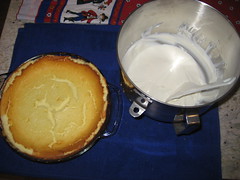
Once the first layer has finished baking and has cooled for about 20 minutes outside the oven, you go ahead and pour this second layer over it and bake it again for 15 minutes this time, still at 350 degrees.
Once that’s done, you get started on your fruit topping as you let the pastel cool to room temperature.
You get a bag of frozen strawberries that you have defrosted (yes, Nitza says 1 package of frozen strawberries in her list of ingredients –I almost keeled over when I read that) and put them, along with the juices that are in the bag in a saucepot. You cover the strawberries and their juices with sugar and flour and stir constantly over low heat until it thickens.
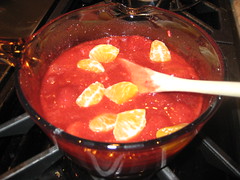
When you start feeling resistance while stirring, you add slices of mandarin oranges, along with the juice from one key lime and you mix it all together. Then you mash it really well with a potato masher to get all the fruit pieces broken down.
Once that fruit compote cools, you can add it to the cooled cheesecake.
Nitza then says that you add pears to the topping, but I added mandarin orange slices instead – I needed the citrus. And, it was more Florida of me to add oranges. Pears are so…Oregon.
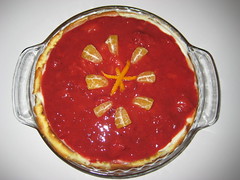
I took my test cheesecake to work the next day and shared it with anyone that would pass by. That is, anyone but those in the newsroom. After all, this was a competition and I was not about to let anyone in the newsroom know what it was that I was preparing.
So, not a peep about my recipe on Facebook, Twitter, nada. Hidden cookbook and test cheesecake under my belt, I was ready for the competition.
When Top Chef-eve rolled around, I made mini cheesecakes, as per the guidance of my food stylist, so that the cheesecake wouldn’t look mushy and destroyed when cut. Since it’s a crust-less cheesecake, it doesn’t hold up well as a pie.
I’m telling you, I don’t know what this recipe looked like in Cuba. If anyone has any photos from the past with this "chiscay" in it, please share!
I took my mini cheesecakes to the office in the morning, snuck them into the Advertising kitchen and hid them for the day.
At 4 o’clock, it was time to start the prepping. I topped them with the strawberry orange key lime mermelada (marmalade) and some key lime and orange slices for dramatic effect. I color coordinated the presentation so well, even my food stylist advisor was impressed.
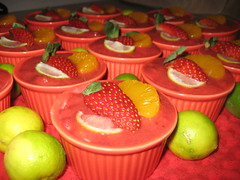
I took my dish up to the newsroom and was the first to arrive.
Rookie here was freaking out while all the veteran Herald Top Cheffers were taking it all in stride.
After I placed my entry in its proper spot, I stepped away from the tables and kept an eye out for competition. Who would I have to beat out to surprise my coworkers as the blogger that really could cook?
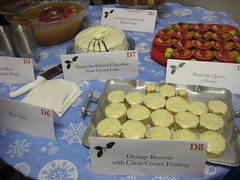
Would it be the two-time reigning champion, Lisett, known for her Best in Show desserts and her Orange Brownie with Citrus Cream Frosting?
Would it be Fred Tasker and his Poor Man’s Champagne Punch he was submitting as an entry for dessert?
Fred Tasker? Really? I shouldn’t be in this competition.
Joan Chrissos from Neighbors, Niala Boodhoo from Business. All in the dessert table.
Can I take my "chiscays" back and go home?
The judges showed up and I just wanted to cringe. Not only was David Landsberg, our Publisher, a judge, but so were:
- Beverly Mills from Desperation Dinners (and Anders’ wife);
- Linda Bladholm, Miami Herald’s cook with a deep understanding of global food and culture (oh no);
- Cristina Arencibia, special food contributor to El Nuevo Herald (ay dios mio!)
I put on my best face as they called us dessert contestants to the middle of the floor. When Iron Chef Cheung asked some of us to step forward and I found myself alongside Lisset, I knew I was safe.
When he asked some of us except for Niala, Lisett and Teresa to step forward, I knew I was a gonner.
And I was. And Lisett lost too, which made me feel a wee bit better.
And Teresa won, which made me feel a whole lot better because she was a total sleeper competitor. I didn’t even know she was entering in the competition and she’s such a great person to work with, I was just elated for her and her Torta de Queso Coronada, which, by the way, I didn’t even try because I had only tried the shoe-in, Lisett's Orange Brownie!
And that was the end of my first competition. No consolation prizes, no second places, no nothing. Teresa was Top Chef Dessert and that was it!
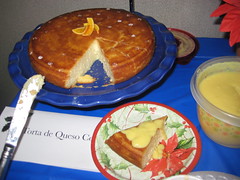
At the end of the day, it was a fun event. Everyone participating had a great time and my dear friend Silvi even won with her total random entry of Cuban Black Beans and Rice with a dollop of sour cream and citrus zest (not that her dish was random, it was her last minute decision to enter that was random). Those beans give my mother in law’s beans a run for their money.
So, at in the end, it was another recipe made, a first experience at a competition and a newfound respect for anyone that has to prepare food to be consumed en masse.
Herald Top Chef I may not be, at least not this year. But wait until the secret ingredient next year ends up being Patagrás cheese and chicharrones – two of Nitza’s most commonly used ingredients. Now we’re talking!
Tuesday, December 8, 2009
KFC, Abuela style
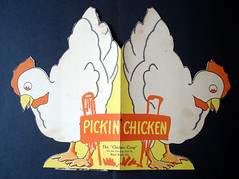 Photo courtesy of: RetroJason via Flickr
Photo courtesy of: RetroJason via FlickrWhen I sat down to pick my next recipe, I came across this one and realized that it was none other than southern style fried chicken. Rich batter fried chicken. Nitza calls this Pollo a lo Miami, which is confusing because why would anyone think that batter-fried chicken is chicken Miami-style?
Growing up, my husband and his cousins used to go to the beach every weekend with their aunt Bivi and a bucket of fried chicken from KFC, or as Bivi would call it, Pickin’ Chicken. They would play in the beach for hours, come out and eat sandy greasy chicken and go back in the water to play.
Many of us have grandmothers and aunts that – to this day – call KFC, Pickin’ Chicken. Many of us don’t know why, but from what I found out, there was a restaurant in Miami Beach that was called Pickin’ Chicken. Did our grandmothers name KFC, Pickin’ Chicken, just because it was their first experience with fried chicken made this way?
I don’t know, but if anyone does, please feel free to share.
Recipe #166: Pollo a lo Miami
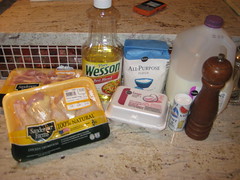
This recipe looked easy enough, I decided I wanted to attack it while in the midst of US1 traffic on my drive home one night. Thanksgiving had taken so much out of me, two weeks had almost gone by without another cooking session.
I called my parents, told them to come on over and we were on our way to eating fried chicken for dinner. There was nothing tricky about this recipe. Nitza had asked that I get a two pound chicken and cut it into eighths. Well, now that I’m fifty recipes into The Project, I knew better and planned for a quick stop at Winn Dixie on my drive home to pick up the pre-cut chicken parts.
The eyes are rolling. I know, I know. There’s nothing quick about any of this, but this time, I swore, it was going to be fast.
I got home (thirty minutes later thanks to rush hour traffic I had jumped out of), plopped the chicken on the counter, took out an egg, milk, flour, salt, pepper and vegetable oil – I was ready. See, easy.
I whisked the egg with the milk, flour, salt and pepper while I heated the oil in a cast-iron skillet (my first skillet and this was a great way to break it in!!).
When I dipped the first piece of chicken in the batter and threw it in the oil for frying, I felt like if I was making a down home southern fried chicken – seriously. Someone pass me a biscuit!
This thing was southern southern southern – and Nitza called it Miami-style?
After cooking each piece for about ten minutes, my family was ready (and starving). Nitza says that ten minutes is all you need, so when I took out the biggest piece and cut into it to check for doneness, I sheepishly smiled at my family and told them to find something else to do for a few minutes. This chicken was raw.
Back in the skillet and about twenty minutes later, we were done.
And, wow. This was some good chicken. Colonel Sanders or Pickin’ Chicken? It’s all the same to me. Down home southern fried chicken – finger lickin’ good!
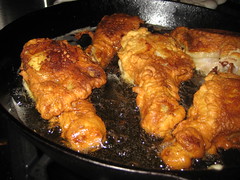
Speaking of finger lickin’ good, when I went on the KFC’s website to look at their history, I found out that the pressure cooker was introduced in 1939 and that Colonel Sanders used to fry his chicken using one to give his customers fresh chicken, faster.
Maybe I should try that next time – but how would that even work? A pressure cooker with oil? Oh, no, I feel a nightmare about chefs without arms coming on.
Thursday, November 26, 2009
Thanksgiving - Nitza Style
My husband and I have been hosting Thanksgiving since 2005. All of our holidays before then had my husband and I doing time between my family’s house and his family’s house. As the years passed, we started timing the gatherings so that we could be in all places in one day – quite exhausting, but we would have a chance to see everyone. Thanksgiving used to be brunch at my grandparents’ house, late lunch with my father-in-law’s sister and her side of the family, and dinner was always at Moki’s house, my mother in law’s sister.
When Moki passed away in early 2005, the family tried to split up the holidays. I took Thanksgiving, partly because my husband had been frying turkeys for the past few years and I figured I would get out of making turkeys as part of this holiday ownership.
This year, when it came time to think about Thanksgiving, I’ll tell you, I would freeze at the thought of planning the menu. I knew I had to it based around The Project, but was totally hating the thought of having to make a turkey.
I would have visions of my grandfather basting, basting and basting. I would see Tia Gladys (my father in law’s sister) on her feet for hours and I would think of Moki’s house that since we would show up at around 9 p.m., I had no idea of the work that went into the turkey prep. I was scared out of my mind.
I sat with my cousin, Jessica, the first week of November, and we planned the menu. We divided and conquered, giving everyone a role and their dish. My mom’s spinach dip, my mother in law’s beans, Bivi’s white rice, Jessica, Hilda and Claude with the sides and desserts. My husband and his two fried turkeys, Tia Alina with a turkey breast, and me with my Cuban turkey and mashed potatoes with cheese.
Were we feeding an army? No. Just about twenty Cubans and Cuban-affiliates.
I’ll start with the potatoes because they were so easy and so gooooooooood.
Recipe #246: Pure de Papas con Queso
Potatoes for twenty is crazy. I bought ten pounds of potatoes in my true spirit of exaggeration. I also bought one of those industrial-sized turkey pans so I could put my mashed potatoes in once they were ready.
Once you peel your potatoes and cut them up into smaller pieces, you put them in a large pot, cover them with water and boil them until you forget that you’re boiling them. When you remember that you’re boiling them, you check for doneness. If they smash with a fork without effort, they’re ready.
Strain the potatoes and put them back into the pot you cooked them in. Mash mash mash, then pour into the large pan to add the rest of the ingredients – salt, two sticks of butter and four bars of cream cheese.
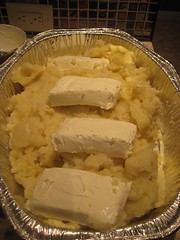
Yes, four bars of cream cheese and two sticks of butter – for twenty. If you just want to make one recipe, you only need one bar of cream cheese, a little more than a third of the stick of butter to about three pounds of potatoes. Still very rich, but drop dead good (and drop dead prone if you make this recipe on non-Thanksgiving days).
And, without further delay, here is the story on the Cuban Turkey.
Recipe #164: Pavo Relleno con Congri
Days and days and days of prepping. Did Abuelo Pepin, Tia Gladys and Moki do it this way? Or, will I, after years and years of learning, finally do this in my sleep like they made it seem?
Sunday started with a trip to Publix to buy all the ingredients. Luckily, my husband and I had seen Alton Brown’s Dear Food Network special on Thanksgiving earlier that day and we were totally psyched for our mission.
Alton had given us the go ahead on buying Publix’s frozen turkey (the one with the purple stripe on the bag) because that’s the one he uses for himself. He gave us all the reasons why, you can check on the Food Network website for more details.
Alton had also talked about stuffing and a contraption he used to stuff his birds. Coincidently, I found it on a random trip to the Container Store that day, so I was really ready for my congri-stuffed turkey.
Monday, I thought about my prep steps and freaked out. I wrote down my step-by-step process and tried to put Wednesday out of my mind.
Tuesday, I thought about Wednesday and freaked out some more. I also started to defrost my turkey because Alton had recommended doing so for about 48 hours in the fridge so it would thaw out appropriately.
Wednesday, I thought I had to prep at night and that there was no turning back. I freaked out even more.
I took out all the ingredients and my step-by-step process and started to get to work on the marinating of the turkey.
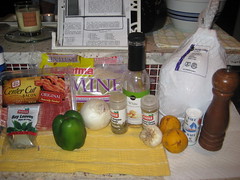
First thing I had to do was to clean out the turkey. I think that was the worst part of the recipe. That was gross. Sounds childlike, but it really is gross.
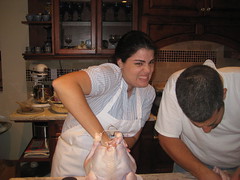
The marinating is really easy and a great recipe that can be used on anything – minced garlic, salt, pepper, cumin, oregano and sour orange. You rub this mix inside and outside the turkey liberally. You can instantly taste what will happen because of this marinade. You then add thin onion slices to the top and the sides of the turkey.
I had bought some oven bags at Publix because I couldn’t think of anything else to marinate my turkey in overnight. That was a good move. The turkey fit perfectly in the bag and I had placed the turkey inside the bag before adding the marinade so all the juices would be locked in the bag overnight.
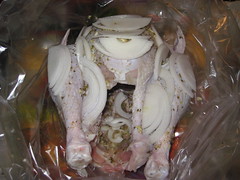
Good night, dear turkey. See you in the morning. Away to the fridge you go.
When I started to work on the turkey, I had placed a bag of dry black beans for congri (see – black this time, red last time, no pattern) in a bowl and covered them with water. Now that I was done with the turkey, it was time to start on the congri that would be the stuffing for the turkey.
I took the beans, their now black bean water and a green pepper and put them in the pressure cooker. Put them to cook for 30 minutes.
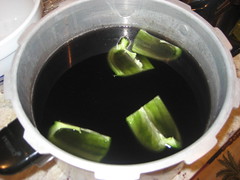
While the beans cooked, I prepared the pretty green trilogy (garlic, onions, green peppers) in the food processor. I took some bacon and fried it up in a deep pot. Once the grease was released, I removed the crispy bacon for later on. I added the Cuban trilogy to the bacon grease and when the sofrito was ready, I added everything from the pressure cooker (beans and a good amount of liquid) into the deep pot. I also added salt, black pepper and oregano, along with a bay leaf. Once it started to boil, I added the white rice and brought it back up to a boil. Then, I covered it on medium-low and let it cook for 20 minutes.
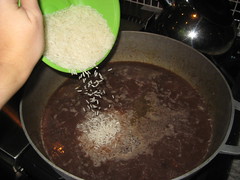
The grains of rice should be undercooked. You’re supposed to take the congri off the heat early since you’re cooking it again inside the turkey.

Time for bed. 2 a.m. Big day ahead with my daughter’s class performing at mass, cousins coming over after mass for the kids to play, Tia Gladys’ at 1 p.m. and our dinner at 7-ish.
Thanksgiving morning came too soon. After mass, we got home with our little pilgrims, and I started to peel the potatoes with my cousin, aunt and mom keeping me company. I left them in water so they wouldn’t turn brown and we left to Tia Gladys’ house.
Tia Gladys' Thanksgiving consists of about 40 people and includes your usual Cuban Thanksgiving dishes - pig (caja china-style), turkey, black beans and rice and cuban bread, to name just a few of the dishes.
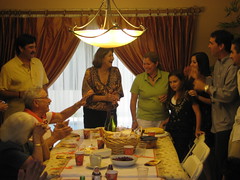
This year I watched as Tia Gladys took out everything she had made, except for Nena’s Sweet Potatoes, which are the greatest sweet potatoes in the world.
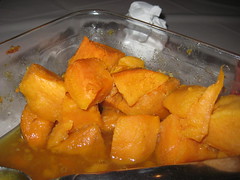
Nena is Gladys’ daughter and my husband’s first cousin. She has given me the recipe for her sweet potatoes before, but I can almost bet that she leaves something out so they don't come out like hers.
At the end of the meal, Tia Gladys brings out those fancy Cuban desserts like a cake with glossy jelly stuff on top. That’s gross. And I know I’m going to have to make something like that in the desserts chapter, so I cringe when she brings it out.
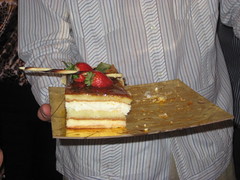
We go home and it’s time to get to work. Big time.
Hello Señor Pavo, it’s time to get to work. I’ll need five hours of your time, so come with me as I prepare you for your baking.
As I take the turkey out of the oven bag, I place it in it’s roasting pan and bring out my congri from the fridge and my Alton Brown stuffing contraption. I fill up the stuffing pusher with congri and ask the bird for forgiveness as I stuff it with congri.
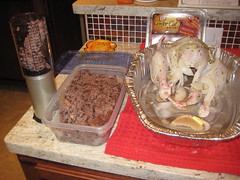
But, with the first bit of congri that I put into it, the bird plumps up and I can see a beautiful turkey taking shape. Well, of couse, I get totally carried away, so I stuff the congri into the turkey like crazy until it’s practically twice it’s size.
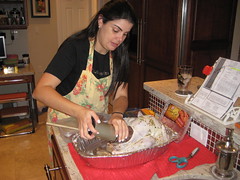
(Note: bad idea. Why? Because then you have to cook the turkey for an indefinite amount of time because this log jam, caulking of stuffing doesn’t let the turkey cook through. So, next time, I won’t be so exaggerative and I’ll just stuff it like a normal person and won’t have to stress about putting the turkey back in, and back in, and back in the oven.)
Once the turkey is stuffed, you close it up with this really cool turkey sewing kit I found at Publix.
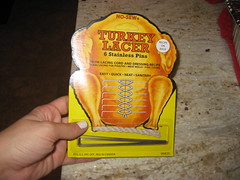
Then, you artistically wrap it with bacon. So pretty. I thought wrapping a turkey with bacon was a new trendy Williams Sonoma type of thing. Who knew that Nitza had been doing this for so long. This was going to be fun.
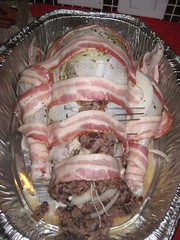
Once the bacon is in place, you pour dry white wine over it and put it in the oven for three hours (or five if you go crazy with the stuffing).
The presentation for the turkey, once done, was impressive. The congri was coming out of the turkey and it tasted just like the seasonings I had used for the marinade.
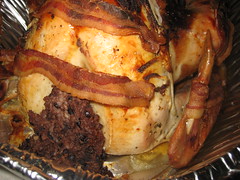
My turkey was not perfect, by any means, as we were eating by 10 p.m. because of all the times I had to put the turkey back in, but it was well worth the effort.
We had way too much food, as always, but our cousins came to pick up the leftovers the next day to have a leftover dinner. Food to bring the family together for days and days. It’s good to exaggerate.
About the blog
 Inspired by Julie & Julia, I've embarked on my own project: to celebrate the Cuban kitchen -- the food, the abuelas who prepared it, and the family that gathered around the table to enjoy every bite. For my generation -- and for my kids' generation -- I'm cooking my way through Nitza Villapol's Cocina al Minuto. With each recipe, I'm taken back to what those housewives of my grandmother's and mother's generation must have been thinking as they tried to follow Nitza's instructions, from her books or TV program. I hope this project moves you to learn how to cook, simply, and to bring the joy (and sofrito smell -- the smell of home frying) back into your home. Click here to read previous posts. Click here to read The Miami Herald article on my journey. ¡Buen Provecho!
Inspired by Julie & Julia, I've embarked on my own project: to celebrate the Cuban kitchen -- the food, the abuelas who prepared it, and the family that gathered around the table to enjoy every bite. For my generation -- and for my kids' generation -- I'm cooking my way through Nitza Villapol's Cocina al Minuto. With each recipe, I'm taken back to what those housewives of my grandmother's and mother's generation must have been thinking as they tried to follow Nitza's instructions, from her books or TV program. I hope this project moves you to learn how to cook, simply, and to bring the joy (and sofrito smell -- the smell of home frying) back into your home. Click here to read previous posts. Click here to read The Miami Herald article on my journey. ¡Buen Provecho!Saturday, November 21, 2009
Congri - Round I
When I decided I wanted to make a Cuban Turkey for Thanksgiving, I made sure Nitza had a recipe for it. I wasn’t going to try to do my first turkey without Nitza. She has a recipe for a congri-stuffed Turkey and, I figured it would be good to practice making congri first before feeding 20+ a first time turkey and first time congri. Good thing Nitza has two congri recipes – this one here and the one for the turkey. Not sure why they’re different, but I guess I’ll find out.
Recipe #221: Congri
Apparently congri is one of those Cuban recipes that are debatable. Red or black beans. Cook on the stove or in the oven. This recipe calls for red beans, but right under this recipe (#222) is Moros y Cristianos (which translates literally into: Moors and Christians. That recipe calls for black beans and white rice. But, some debate whether the Moros y Cristianos are the red beans and rice and the congri is the black beans and rice.
Nitza doesn’t settle it, either. In my Cuban Turkey for Thanksgiving, the congri recipe calls for black beans. So…maybe it’s a family thing. To me, congri has been black beans and white rice all together, which tastes completely different than when you put white rice and black beans on your plate.
Ahhh, the joys of Cubanisms. Nothing makes sense and everything is right. That’s just the way it is.
And, for my friends on facebook that quickly took my unofficial survey and came to no consensus about red or black being the right color for the congri bean, thank you: Vivian, Michelle G., Mariela, Jenny, Elsy Elena and Claude.
Anyways, back to the recipe.
Take your red beans and soak them overnight if you have time. If not, you put them in a pressure cooker with enough water to cover them and then some (I know, I sound like your abuela saying that, but it’s the right thing to do). Put a green pepper in there with the water and the beans. (Note: although my picture below is a thing of beauty (to me), it's not practical. Cut the green peppers in big chunks - otherwise, they're a bear to pick out.) I cooked them for 30 minutes since I hadn’t soaked them overnight and I wanted to make sure they were soft enough.
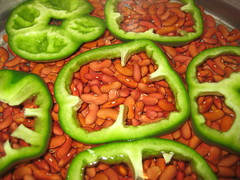
While you have the beans in the pressure cooker, start getting the rice ready for later on. You fry up some bacon in a deep pot (can be the same one you’ll use to make the congri in) and once they’re crispy and done, you remove half of them and half the grease they release. That you save for later (no joke). Add the rice to this remaining half grease and bacon and coat it well. Ahhh, the arteries are screaming for help.
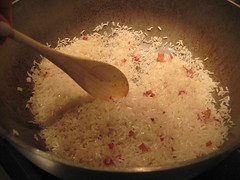
Set your grease-coated, bacon rice aside.
Once the beans are done, you take them out of the pressure cooker, you strain them and reserve three cups of the bean liquid. (Note: Nitza says three cups, I’d save five cups just in case).
You take pork and cut it into chunks and put the chunks in a deep pot over high heat. Once they have released their grease, it’s time for you to sofreir some onion, green pepper and garlic that you have food processed. Then, add the frijoles.

Since food processing the vegetables together makes them liquidy, you may be stunned when you see your bright green Cuban-trinity (onion, green pepper and garlic) mix in with the pork fat and the beans. I don’t know why, but I was amazed by the bright green and I could just taste how it would affect the dish in the end as it cooked through all the ingredients.
Once you’ve covered everything in the green and the green isn’t green anymore, you add the bean liquid (make sure you cover everything with the liquid you add), salt, pepper and a bay leaf. All of this still on high heat.
When you bring everything to a boil, add your grease-coated bacon rice and bring back up to a boil.
Lower the heat to medium and let it cook, covered, for thirty minutes.
Right before serving, take the other half of the bacon, crumbled, and the bacon grease and toss it into the congri.
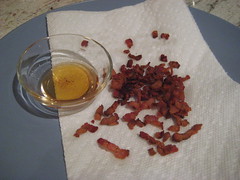
Seriously, who thought of that?
Hey, let me reserve some grease to swirl over my dish as a flavor enhancer.
¡¡¡Dios mio!!!
My congri turned out to be a bit dry and I think it may have been because I didn’t let the beans sit for a few hours in water before cooking them. I skipped it because I felt it was just an old 1950s thing, but it would help (as I learned for my real Thanksgiving congri that came out better).
The way I think of it, if you let the beans sit in enough water to cover them for at least two hours before cooking, they’re getting the water in and letting the water out that they need. Once you put them in the pressure cooker, they have enough moisture and don’t need any more – they just cook in the pressure cooker as they should.
If you go straight to the pressure cooker, the dry beans start to look for water in there and don’t leave as much water in the end.
Maybe that’s a very long way of explaining it, but my moist beans (for Thanksgiving) did much better than these poor dry red ones and this is my explanation for why.
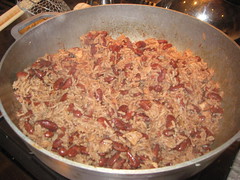
So, there you have it. Congri. Not too daunting. I was actually loathing having to make congri because it’s just something that’s there, but it’s not a Cuban dish I love. I’m more of a white rice and black beans kind of girl.
About the blog
 Inspired by Julie & Julia, I've embarked on my own project: to celebrate the Cuban kitchen -- the food, the abuelas who prepared it, and the family that gathered around the table to enjoy every bite. For my generation -- and for my kids' generation -- I'm cooking my way through Nitza Villapol's Cocina al Minuto. With each recipe, I'm taken back to what those housewives of my grandmother's and mother's generation must have been thinking as they tried to follow Nitza's instructions, from her books or TV program. I hope this project moves you to learn how to cook, simply, and to bring the joy (and sofrito smell -- the smell of home frying) back into your home. Click here to read previous posts. Click here to read The Miami Herald article on my journey. ¡Buen Provecho!
Inspired by Julie & Julia, I've embarked on my own project: to celebrate the Cuban kitchen -- the food, the abuelas who prepared it, and the family that gathered around the table to enjoy every bite. For my generation -- and for my kids' generation -- I'm cooking my way through Nitza Villapol's Cocina al Minuto. With each recipe, I'm taken back to what those housewives of my grandmother's and mother's generation must have been thinking as they tried to follow Nitza's instructions, from her books or TV program. I hope this project moves you to learn how to cook, simply, and to bring the joy (and sofrito smell -- the smell of home frying) back into your home. Click here to read previous posts. Click here to read The Miami Herald article on my journey. ¡Buen Provecho!Monday, September 28, 2009
35: Picadillo
1/4 cup oil
1 onion, chopped
1 green pepper, chopped
1 garlic clove, minced
1/2 lb. ground beef (80/20)
1/2 lb. ground prok
1/2 lb. ground ham
3/4 cup capers
1 teaspoon salt
1/8 teaspoon black pepper
1/2 cup tomato sauce
1/4 cup dry white wine
1. Heat the oil and fry the onion, garlic and green pepper, until softened.
2. Add the three meats and cook until they just start to cook through.
3. Add the remaining ingredients and cook, covered, for 20 minutes on medium heat.
Makes 6 servings.
Pumpkin Soup and Picadillo, Too
Getting to picadillo was a treat. My husband and I usually make some sort of ground turkey rendition that sometimes leans towards picadillo and other times leans towards chili without beans when we add cumin. But this was the time to really make picadillo, the Cuban way, and it was surprising to learn all the ingredients that went into it – not just one type of ground meat.
Since I had decided to do this on a weeknight, I wanted to keep things simple, but because I was already going for it, I threw in a vegetable cream soup to get another recipe in. Happy to report, that even though there were three items I made on a weeknight (killer white rice, of course, with the picadillo was the third dish), we were eating by eight o’clock. Later than I wanted for my kids, but good enough since it was a fully home cooked meal.
Recipe #9: Sopa de Calabaza a la Crema
Now that October was right around the corner, I had wanted to kick off the orange-themed season right. Luckily, the next soup in the creamy vegetable soups part of the soups chapter was for creamy pumpkin soup.
I had bought a bag of frozen pumpkin on a recent trip to the grocery store, so I had that on hand for the dish. Taking the basic recipe for cream of vegetable soup and adding the desired vegetable is the routine for seven recipes.
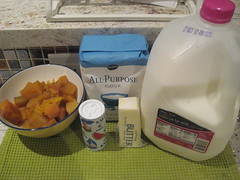
The basic recipe calls for:
3 T butter
4 t flour
2 cups milk
1 t salt
1 cup of the desired vegetable, cooked and mashed
Once you melt the butter over low heat in a caldero or large pot, you put the flour, milk and salt in a bowl and hand blend it until it’s well mixed, without flour lumps. You pour that mix into the pot with the melted butter and you let it heat through, still over low heat. You can be adventurous and play with the heat if you’re standing there because the more heat you put into it, the faster it thickens. But, there’s a fine line between thickening it and burning it, so leave it over low heat if you want to play it safe, stir every so often in-between prepping for your next dish, and once you feel resistance with your whisk or spoon, go ahead and pour in the cooked and mashed vegetable (pumpkin, in this case).
Once you pour in the mashed pumpkin, since it’s still warm from being just cooked, it will heat through with the rest of the liquid and you’re done. Leave the soup covered, on simmer, serve it when ready.

This recipe was ok. It wasn’t a fancy creamy pumpkin very orange soup you’ll get at a trendy restaurant or from a Food Network recipe. I had something else in mind going into the recipe and when I tasted it, it wasn’t what I was expecting. Not to say it wasn’t good, but you have to know going into it, that you’re making a vianda (vegetable) type of soup.
I had taken some leftovers to work and when one co-worker started feeling under the weather, she had some for lunch and it hit the spot and gave her a lift. Maybe this is one of those Cuban-remedies type of foods?
Whatever it is – two creamy vegetable soups down, five more to go!
Beef, pork and ham – those are the three types of ground meat that Nitza’s picadillo calls for. You definitely have to plan ahead, even if just a little, to get this one started. I have these meats in my freezer now because of The Project, but before, you’d only find frozen ground turkey on a regular basis.
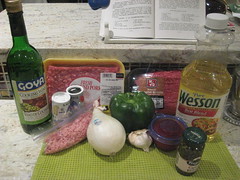
I searched through the recipe and didn’t find raisins. I particularly don’t prefer raisins in my picadillo, but when I saw alcaparrado (capers) in there instead, I was intrigued. After heating some vegetable oil and sofriendo some onion, garlic and green pepper in it, we were ready for the triple-meat combo. You mix the ground meats in with the sofrito and you stir it all well so it doesn’t stick to the pot.

Once the meat is good and cooked, you add in the capers, salt, pepper, tomato sauce and vino seco (dry white wine). Stir it up and leave it over medium heat for twenty minutes.
I did have to call up for help on a doubt I had: to lid or not to lid?

After posting this question on Facebook, I had a slew of friends weighing in:
Armando says, "Depends on how dry you want it. If you go "topless," make sure to turn down the heat a little or you'll risk drying it out too much."
Maritere says, "I always lower the heat and cover it for at least 15 minutes. Seems to absorb more of the flavor that way. If still too liquid at the end, then I raise the temp again for a few minutes with the lid off to allow some of the liquid to evaporate."
I went with the lid on for the full 20 minutes and it was absolute perfection. The next question is – picadillo on top of the rice, or picadillo side by side with the rice. The debate could go on forever!
